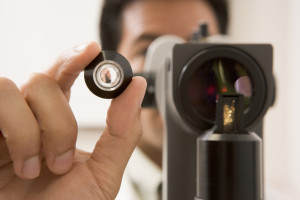When we think of “life-saving screenings,” we don’t often think of eye exams. But a visit to the ophthalmologist truly saved Dean Barrick’s life.
When we think of “life-saving screenings,” we don’t often think of eye exams. But a visit to the ophthalmologist truly saved Dean Barrick’s life. Dean’s wife, Teresa, a clinical nurse leader at Levindale, recalls that Dean “complained that his eye was bothering him,” so she called the Krieger Eye Institute. “Once I mentioned that he had pain, the receptionist moved him up immediately,” Teresa adds. That quick thinking was pivotal – Dean’s eye pain soon revealed itself to be something far more serious.
“Mr. Barrick presented with classic symptoms for retinal detachment,” explains Justin Shaw, M.D., one of the ophthalmologists who examined Dean. These symptoms included flashes of light in Dean’s peripheral vision as well as “floaters” (or small, shadowy specks) that hovered over his field of sight. Along with his colleague, Philip Scharper M.D., Shaw looked over an angiogram and ultrasound of Dean’s eye; they quickly found that the cause of this detachment was a mass that showed characteristics of melanoma, a malignant tumor.
“When I heard that, I felt punched in the gut,” Teresa says. She remembers sitting down with the doctors as they patiently – and thoroughly – explained Dean’s condition, and the options for treatment. According to website for the Ocular Oncology Service at the Wills Eye Institute in Philadelphia (one of the world’s most eminent treatment centers for eye cancers, tumors and diseases), “Melanoma carries the potential to spread from the eye to other parts of the body.” Melanomas are estimated to effect between 2,000 and 2, 500 Americans each year, and they usually originate within the skin – eye melanomas are considered quite rare.
That was little comfort to the Barricks. Fortunately, they received the full attention and dedicated care of Shaw and Scharper, who helped arrange a consultation with Jerry and Carol Shields, the director and associate director (respectively) of the Ocular Oncology Service at the Wills Eye Institute. Less than a week after Dean’s diagnosis, the Barricks had their bags packed for Philly. “Drs. Scharper and Shaw were in contact with the Shields; they had a vested interest in us,” Teresa says. “They were emotionally involved, very compassionate and professional. Dean had a lot of trust – complete faith, really – in them.”
This network of incomparable care providers was able to shepherd the Barricks through an unenviable decision: After rigorous rounds of testing and intense conversations, Dean would opt to have his eye removed in the hopes of preventing a potential reoccurrence. Though there was an adjustment period (as there is after any major surgery), soon, Dean was able to walk back into his life. Everyday simplicities became moments of celebration. Teresa remembers looking out the window to see her husband in their garden, picking vegetables and preparing to make salsa. “Our doctors at Krieger, especially Dr. Shaw, really helped him through this,” she says. Dean returns to Krieger twice a year for check-ups. “An optician just can’t examine your eyes the way that the doctors at Krieger can,” Teresa adds.
Being proactive about seeking treatment was also a pivotal factor in Dean’s recovery. “Patients should see an ophthalmologist immediately if they ever have new flashes of light (especially way off to the side of their vision), any new floating objects in their vision or any shadow or ‘curtain’ over any part of their vision,” explains Shaw. Teresa Barrick wholeheartedly seconds these words of wisdom: “I never knew that an eye exam could save your life.”